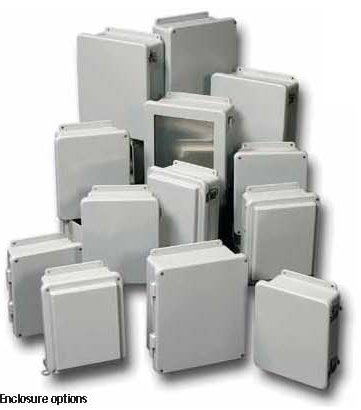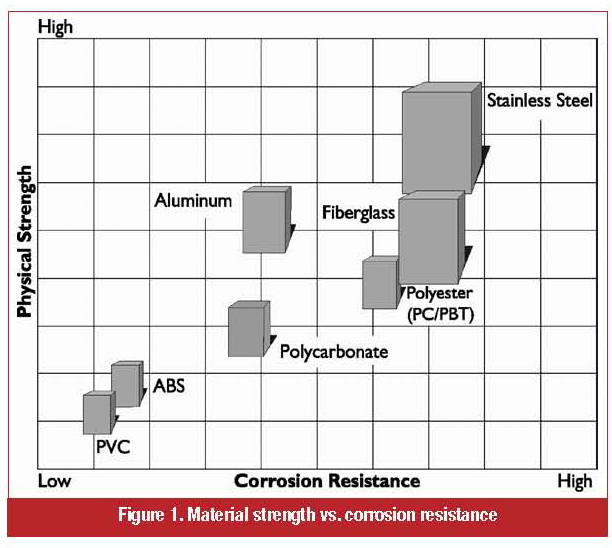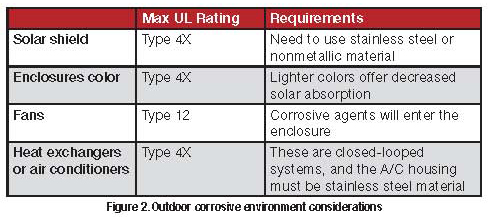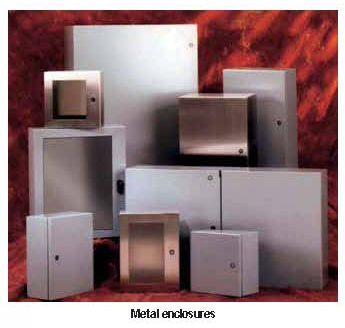Many considerations must be made when selecting an enclosure.
The Evolution of Electrical Enclosures
An enclosure is a housing constructed to provide a degree of protection from accidental contact with the enclosed equipment and external environmental conditions. It has evolved from being a simple container, with a screw cover design and termination point to enclosures including hinges, latches, pushbuttons, and switches. Enclosures today have evolved to help protect interactive systems, remote data reporting and complex/interrelated technologies. Included in this evolution process has been the availability of material choices.

Materials Available for Electrical Component Protection: The Basics
1. Enclosures can be made from metallic or nonmetallic material but must serve its function of protection for the life of the installation
2. Durability and longevity is key
3. There are three typical types of materials available: composites, metal and thermoplastics
Composites: The Basics
Thermoset materials, such as a polyester resin combined with glass, create a unique composite fiberglass reinforced polyester (FRP) that is exceptionally durable and weather resistant. Like thermoplastics, FRP provides a greater degree of corrosion resistance than painted carbon steel, yet, will perform better than metal and plastics in extremely harsh environments.
Metal: The Basics
Common metal enclosure choices included carbon steel, stainless steel and aluminum, with carbon steel being the most prominent choice based on its low initial cost. Carbon steel is typically galvanized or painted to prolong the service life. Premium metals such as stainless steel and aluminum are used where long life, corrosion resistance and weatherability are critical, such as protecting controls for junction boxes in applications.
Thermoplastics: The Basics
Thermoplastics—such as polycarbonate, polyester, ABS and PVC—offer a degree of corrosion protection beyond painted carbon steel. Thermoplastics are more susceptible to UV exposure and weathering degradation over time. Certain stabilizers are now added to extend the life of the enclosure, but ultimately, the nature of the thermoplastics will yield to extended weathering.
Influential Factors to Reduce the Failure of Enclosures
Often trade-offs between performance, acquisition cost and life cycle cost are made in the process to find the ultimate choice for a unique application. Consider these factors that influence the enclosure specification for applications and how each type of enclosure might stack up:
• Environmental considerations
• Standards requirements
• Physical characteristics
• Electrical characteristics
• Thermal management
• Condensation
• Cost solutions
Rating Standards: A Starting Point for Your Selection
• Type 1, indoor use only, falling dirt
• Type 12, indoor use only, falling dirt, splashing liquid
• Type 13, indoor use only, seepage water, oil and coolants
• Type 3R, indoor/outdoor, falling dirt, rain, sleet and snow
• Type 4, indoor/outdoor, hose-directed water
• Type 4X, indoor/outdoor, corrosion, hose-directed water
• Type 6, indoor/outdoor, temporary submersion
• Type 6P, indoor/outdoor, prolonged submersion
Indoor vs. Outdoor: Both Environments Have Special Considerations
An indoor environment will typically be controlled with no direct exposure to the elements—such as sun, wind, rain and snow. It can be a secured area in which building temperature can be controlled. However, many enclosures will be placed in chemical control rooms that tend to be highly corrosive areas. Some of the enclosure materials with low performance in chlorine environments include: galvanized steel and liquid painted steel. Enclosure materials that are preferred options for this type of environment include fiberglass, stainless steel, ABS and polyester (no glass fill).
In an outdoor environment enclosure materials can fade due to sun damage and extreme temperatures can affect the performance of some materials. Enclosure materials with low performance in chlorine environments include polycarbonate and ABS. Materials with optimal performance include fiberglass and stainless steel.
Material Strength vs. Corrosion Resistance
Strength measures the resistance of a material to failure, given by the applied stress (or load per unit area, tensile and compression). Strength is a measure of the material's ability to withstand stretching or compressing under load. On the other hand, the material's toughness is its ability to withstand sudden impacts.
Increasing strength, tensile or compression, usually decreases toughness and vice versa. Whereas steels often have high strength, they exhibit low toughness which means they dent easily and are difficult to drill or penetrate. Thermoplastics and thermosets (composites), exhibit average strength but high toughness. This means that they can withstand sudden impact and maintain their shape.

Physical Characteristics: Special Considerations
One factor that must be considered is how abrasive resistant the enclosure must be. Some options to think about are:
• Corrosion & chemical resistance—especially when exposed to chlorine or Acid
• Flammability—understand UL 94-5VA or non-halogenated options
• Safety—non-conductive or will you need modifications to secure controls
• Impact resistance—look into modulus of elasticity ASTM D638
• Sunlight, UV resistance—ask enclosure manufacturers to inform you of their UV protection available
• Appearance—the finish or color choices, many new options for color are available
Thermal Management: Keeping the Optimum Enclosure Temperature Is Important
Electronic equipment operates best and lasts the longest if its operating temperature is limited. For every 10 degrees C/18 degrees F above room temperature that an electronic device operates, its life expectancy is reduced by 50 percent. Outdoor applications must stand the rigors of heat and cold, as well as dry and wet conditions. Indoor environments can be effected by other equipment.
Outdoor Environment
When choosing enclosures for an outdoor application, heat factors—such as the sun—and the geography of the location must be considered. In addition, an often overlooked factor is other equipment in the surrounding area. Their heat can add to the temperature of the environment. Of course the enclosure material and color will affect the controls inside.

Indoor Environment: Heat Still Needs to Be Taken into Account
Some of the indoor heat factors include equipment—such as variable-frequency drives (VFD), a programmable logic controller (PLC), transformers and limited air flow.
Thermal Management: Benefits of Cooling
Cooling is essential for protecting and maintaining equipment performance. By cooling electrical equipment, you can extend operational life, instill smooth performance and maintain valuable equipment warranties. Some options for cooling include: air conditioning, thermo-electrics, heat exchangers and air movers. Each has pros and cons, so evaluate the options carefully.
Condensation Management
Condensation can occur indoors or outdoors and is the result of temperature fluctuations. Moisture can cause costly damage to equipment and corrosives in the air can settle on the equipment. Possible management options are:
• Occasionally wiping out the enclosure
• Drill a small hole in bottom of the enclosure
• Install a heat source, such as a light bulb or heater
• Install thermostats and/or hygrostats
• Install fans for increased air flow
• Install a drain breather
• Install an air conditioner
The Bottom Line
Metallic and nonmetallic enclosures are both viable options for applications in the pumps and systems industry. The performance and value for the specified application, environmental considerations, thermal management, any weight restrictions, aesthetics and of course price must be evaluated. Then the enclosure will perform and will protect the controls as promised by the manufacturer.



